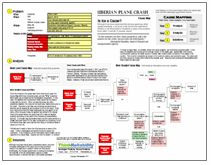By Kim Smiley
For many of us the word lard instantly invokes images of clogged arteries and heart disease. A hundred years ago, lard was a staple item in nearly every pantry, but today few of us can imagine cooking with such an unhealthy substance.
But what if lard isn’t as bad as the collective knee jerk reaction would lead us to believe?
While lard is certainly not olive oil, the reality is that lard is actually a relatively healthy option when a solid fat is needed. This is true because most of the fat in lard is monounsaturated fat, which is healthier than saturated fat. The fat in lard is 40 percent saturated compared with 60 percent saturated fat in butter. The partially hydrogenated fats found in vegetable shortening are now considered to be the least healthy option. While Crisco no longer contains trans-fats, lard has always been naturally trans-fat free.
 So how did lard get such a bad reputation? A Cause Map, a visual, intuitive root cause analysis format, can be built to explore this question. To view a high level Cause Map of this example, click on “Download PDF” above.
So how did lard get such a bad reputation? A Cause Map, a visual, intuitive root cause analysis format, can be built to explore this question. To view a high level Cause Map of this example, click on “Download PDF” above.
A recent article from National Public Radio tried to answer the question – who killed lard? The article claimed that a number of factors contributed to the fall of lard’s popularity. The public became uneasy about the pork industry after the publication of Upton Sinclair’s The Jungle. Included in the book was a disgusting scene that depicted workers falling into vats of lard and being sold along with it for human consumption which understandably cooled the public’s appetite for lard.
A second major factor was that an alternative fat product became available that offered an option to a public queasy about the pork industry. Crisco came on the market, armed with a massive marketing campaign, offering a fat option that wasn’t associated with the pork industry. The creation of Crisco was possible because of the invention of hydrogenation and a surplus of cottonseed oil. The oil had previously been used to manufacture candles, but the invention of the light bulb had dimmed the demand.
At about the same time Crisco was hitting shelves, scientist began asking questions about the saturated fat in lard. Ironically the bad publicity about the health impacts of trans-fats (which were in shortening at the time) was years away, but the early findings that linked saturated fat to heart disease were another strike against the popularity of lard.
Today, lard is making a comeback with foodies, but it still isn’t widely used and it is difficult to find in stores. Only time will tell if lard will once again became a popular pantry staple.



